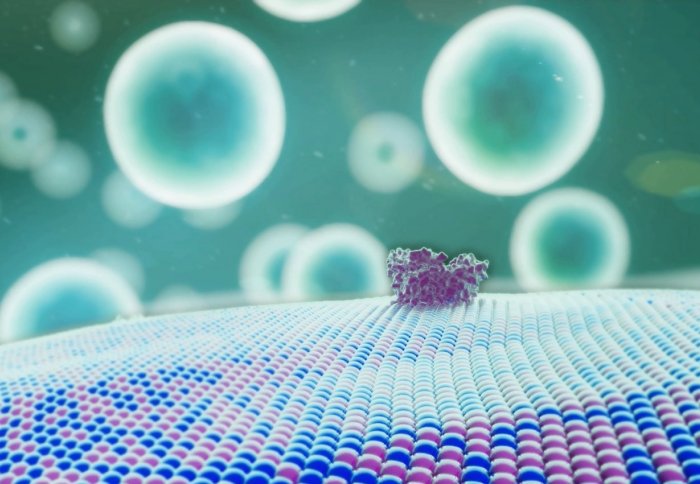

A new PhD programme will focus on cellular bionics - the science of fusing the living and non-living, which will transform bioengineering and design.
The College has been successful in a £1.05M bid for a Leverhulme Doctoral Training Centre that will fund 15 PhD studentships over five years. The programme, funded by the Leverhulme Trust, will focus on cellular bionics – the science of fusing the living and non-living, with applications ranging from biological computers to smart materials.
We spoke with the Director of the Doctoral Training Centre, Professor Oscar Ces, from the Department of Chemistry at Imperial, about how this emerging field is set to change the face of science and society, and how Imperial is perfectly poised to stoke the revolution.
What is cellular bionics?
Cellular bionics is a new field of research that has the potential to revolutionise the landscape of biodesign by engineering symbiosis between living and non-living systems. It will couple the advantages of biological life – for example environmental sensing, self-repair, regeneration, reproduction, directed evolution and communication – with the advantages of synthetic systems such as the ease of interfacing with external electronics and the incorporation of non-biological building blocks.
Cellular bionics will involve harvesting elements of cellular machinery from individual pathways and organelles, like the mitochondria, through to whole cells. These could then be embedded and integrated them into non-living materials and vice versa.
It’s an incredibly exciting field of work because ultimately, cellular bionics will unlock how far the boundaries between the living and non-living can be blurred.
What kinds of projects will the PhD students be working on?
The PhD students will conduct feasibility studies to explore the boundaries between the living and non-living and prototype and model cellular bionic systems.
Projects may look at more fundamental aspects that could transform how we think about life, and how we think about using it.
– Professor Oscar Ces
This will lead to a whole range of different projects. Some will have direct practical applications, such as new hybrid materials able to transmit, receive and interpret signals. These sensor materials could then modify their composition, structure and performance in real time, in response to environmental changes.
Micromachines created from bionic and electronic components could also be used to replicate and synthesize useful chemicals, while some techniques could use biological components in new types of 3D printing.
Other projects may look at more fundamental aspects that could transform how we think about life, and how we think about using it. For example, students could create biological computers and biodevices that exhibit emergent behaviour, where many smaller units act as a larger unit, like a shoal of fish.
They could also create synthetic cells capable of communicating with natural cells, or modelling approaches that can predict the form and behaviour of such ‘quasi-life’.
The applications sound exciting but represent a big change in how we think about ‘life’. How will the ethical and societal implications be addressed?
How we integrate these new technologies into society needs to be an open discussion, and the course will help prepare students to have these kinds of conversations and address any misconceptions. Partnership with civil society groups, social scientists and ethicists will be pursued as a way of understanding critical issues, as will engaging with the public and policymakers.
To make sure students are prepared for ethical reflections and talking about the social implications of cellular bionics, they will all attend a bespoke Research Ethics, Human Experience and Bioethics Course. As well as introducing them to bioethics it will also cover human experience studies, which consider the interaction between humans and the world around them.
How will the students get help turning their ideas into reality?
The programme will cover everything from fundamental science through to prototyping and manufacturing. For this reason, the Centre will be embedded within Imperial’s FABRICELL, the world’s first virtual cellular bionics research centre. It will also directly benefit from the construction of a new bio- and molecular hackspace (FABRICA) and design studio to support the students’ research activities.

The hackspace at White City
This new hackspace will form part of the wider network of spaces that make up the Imperial College Advanced Hackspace and is designed to offer the students access to the cutting-edge prototyping equipment and training needed to undertake cellular bionics research and provide them with a springboard to turn their ideas into working prototypes.
How will the programme be integrated into Imperial?
The new programme will be very interdisciplinary, with the students supported by world-leading training and research expertise from five College Departments (Chemistry, Mathematics, Chemical Engineering, Bioengineering and Design Engineering) and six College Institutes (Institute of Chemical Biology, Agri Futures Lab, FABRICELL, Advanced Hackspace and the Institute of Molecular Science and Engineering).
This is fundamentally important to work in cellular bionics, which is at the interface between the physical sciences, life sciences and engineering.
Supporters

Article text (excluding photos or graphics) © Imperial College London.
Photos and graphics subject to third party copyright used with permission or © Imperial College London.
Reporter
Hayley Dunning
Communications Division

Contact details
Tel: +44 (0)20 7594 2412
Email: h.dunning@imperial.ac.uk
Show all stories by this author




Leave a comment
Your comment may be published, displaying your name as you provide it, unless you request otherwise. Your contact details will never be published.